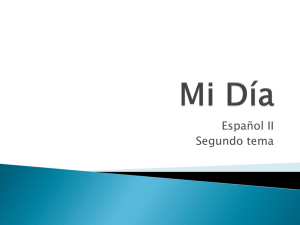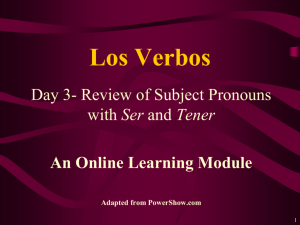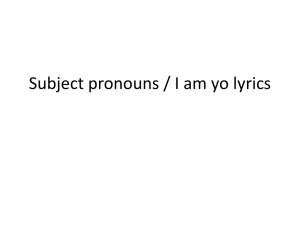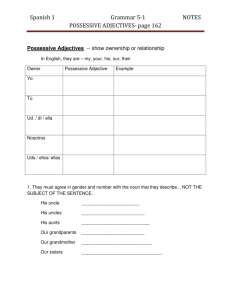Prepositional Pronouns
advertisement
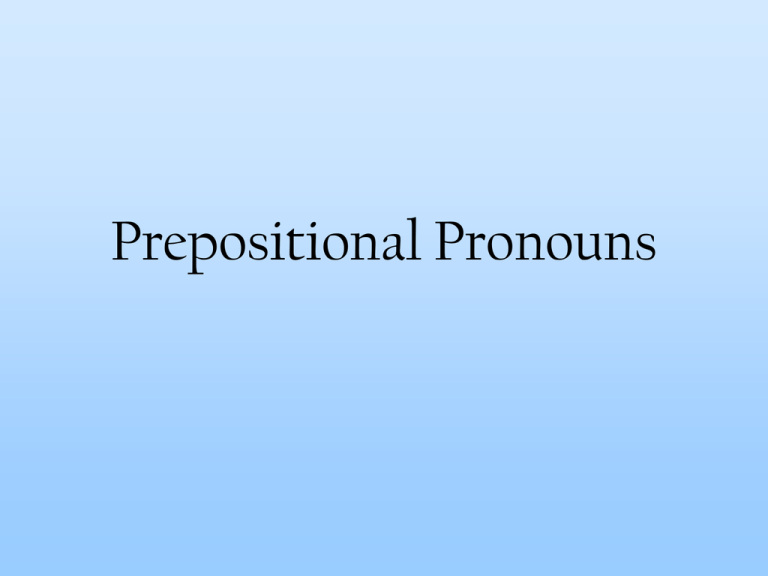
Prepositional Pronouns So what are prepositional pronouns? They’re pronouns that follow prepositions. Unfortunately, these days the next question is “What are prepositions?” You shouldn’t reach college without knowing what prepositions are. Unfortunately, many of you have. Prepositions are words that show the relationship between other words. The boy with the gorgeous smile is my brother. “With” shows the relationship between “boy” and “smile.” He lives in Alaska. “In” shows the relationship between “lives” and “Alaska.” In English, prepositions are usually, but not always, short words: of to in for over from at near under with BUT between during beside outside beneath before inside A large number of Spanish prepositions have “de” with them: después de--after debajo de--under al lado de--beside fuera de--outside antes de--before cerca de--near dentro de--inside entre—between en—in, at, on de—from a—to para--for con—with sobre—on, about durante—during por—for, by In English, direct object pronouns (d.o.), indirect object pronouns (i.o.), and prepositional pronouns (p.p.) are all the same: me you him,her,it d.o. us y’all them i.o p.p. Juan sees me./Juan gave me the rose./Juan lives near me. In Spanish, however, there are three different sets: direct me nos te os lo, la los, las indirect me nos te os le les prepositional mí ti él, ella, Ud. nosotros vosotros ellos, Uds. Let’s look at those again: prepositional mí ti él, ella, Ud. nosotros vosotros ellos, Uds. They look a little familiar. That’s because, with the exception of “mí” and “ti,” they’re identical to SUBJECT pronouns: yo tú él, ella, Ud. nosotros vosotros ellos, Uds. “Mí” probably also looks a little familiar. That’s because you’ve had “mi.” Remember what it means? “My”—mi casa. So the accent mark is important. It makes the difference between a prepositional PRONOUN (mí) and a possessive ADJECTIVE (mi). Let’s see what these pronouns look like in context: Juan habla con ella. Yo compré un libro para ti. Elisa vive cerca de mí. Esa carta es de nosotros. So it’s simple. Whenever you have a preposition and need a pronoun after it, use one of these: prepositional mí ti él, ella, Ud. nosotros vosotros ellos, Uds. And you’ll never guess how you’ll be tested over it: multiple choice But there’s a catch. You’ll have direct objects, indirect objects, reflexives, subjects, and possessives mixed in there. So it might be a good idea to review them. prepositional mí ti él, ella, Ud. nosotros vosotros ellos, Uds. subject yo tú él, ella, Ud. direct object me te lo, la indirect object nos os los, las reflexive me te se nosotros vosotros ellos, Uds. me te le nos os les possessive ADJECTIVES nos os se mi tu su nuestro vuestro su Click here to go to your first homework exercise. Click here to go to your second homework exercise. Below are links to other pronoun lessons: Direct objects Indirect objects Reflexive Subject Possessive ADJECTIVES
